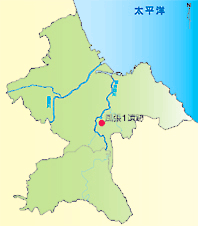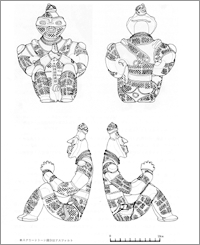
是川縄文館
Outline
History
Floor Guide
Facilities
Permanent Exhibition
Gassyo Dogu
About “Clay figurine with clasping hands (Gassyo Dogu) “
Size: Height 19.8㎝, Wide 14.2㎝, Depth 15.2㎝
Position: Hachinohe City (1-1-1, Uchimaru, Hachinohe-shi, Aomori, 031-8686, Japan)
The way to be listed as a national treasure
30 March. 1997, 666 artifacts from Kazahari 1 site in Hachinohe city were listed as important cultural properties because of these archaeological importance for research to clarify formation of final Jomon material culture (Kamegaoka culture).
10 July. 2009. “Clay figurine with clasping hands” , one of these Important cultural properties, was listed as a National treasure.
1. The Outline of the Kazahari 1 site where the Dogu found
・Location
The Kazahari 1 site is located in 4.3km south of Hachinohe city government office, on the right bank of the Niida Gawa. This site is on the other side of Korekawa-Nakai, where is famous Final Jomon site.
The site is on the tongue-shaped terrace, where lies between meander Niida Gawa in north and swamp in south. Height of the terrace is 20 to 30 meters.
And the site is sandwiched in Niida Gawa of S-shaped in north side and swampy area in south-west side, located on tongue-shaped plateaus of prominent high north-west side at 20 to 30 m. The site reach about 470m from east to west and 250m from north to south. Total area of the site is 75,000㎡.
Map:Location of Kazahari 1 Site
・Excavation results
The kazahari 1 site had excavated for 5 years (from 1988 to 92). 21% of the site (15,700㎡) have been investigated up to now. “Clay figurine with clasping hands” was found at rescue excavation in in July.1989.
As a result of excavation, archaeological remains and features, belonging to Jomon period (initial, middle, late, final ) , Yayoi period, Nara period, Heian period, have been found. The characteristics of the site as follows. First, the site is huge circularity settlements (pits, dwelling and storage are around two cemeteries). It is seems to be hub of settlements at late Jomon. Secondly, many intact artifacts were found in pit dwellings. It is important for chronology reconstruction of settlements in late half of late Jomon.
Picture:No.15 pit dwellings, “Clay figurine with clasping hands” found.
2. How “Clay figurine with clasping hands” found
The Dogu was found at near inmost wall of No.15 pit dwellings. The dogu lied on right side, faced center of dwelling and lean over on wall. When the dogu was found, left foot of the dogu was missing. However, it was found at same pit dwelling 2.5m away from the dogu. Generally dogu is found at midden and out of archaeological features. Therefore, it is rare and important that dogu was found in pit dwelling like “Clay figurine with clasping hands” .
Picture: Situation that how “Clay figurine with clasping hands” found
3. The Characteristics of “Clay figurine with clasping hands”
・The Condition of Dogu
About 70 Dogus was found at Kazahari1site. Nevertheless, no intact dogus without “Clay figurine with clasping hands” . The dogu sit down with its knees up and Its both arms on top of knees with clasping hands as if to pray.
The dogu was seems to be taken good care of and used long time because this dogu fixed with asphalt. And the dogu was probably red painted the whole surface because red pigments remain on some parts of face and body.
Figure:Drawing of “Clay figurine with clasping hands”
・The Characteristics of Dogu from Late Jomon Period, and “Clay figurine with clasping hands”
In northern Tohoku area, many cross-shaped dogus, which dated early and middle Jomon, have been found. In early and middle Jomon, dogus have flat face. In early half of late Jomon, dogu’s faces become three-dimensional and foots become be expressed on dogu. In late half of late Jomon, pregnant dogu and sitting and posing dogu appear.
Most of sitting dogu folded its arms and sitting dogu with clasping hands are only two. That is findings of Kazahari 1 site and Ishigami site (Thugaru city Aomori pref). But whole shape of Ishigami’s dogu cannot be figured out, because its jointed head and body are different individuals. Dogu of the kazahari 1 site is intact and was made more elaborately than others.
4. Date of “Clay figurine with clasping hands”
The dogu is dated late half of late Jomon (about 3,500 years ago) because of stylistic chronology of pottery and dogu.
5. The Brand of ” Clay figurine with clasping hands “
Hachinohe City registered brand “Clay figurine with clasping hands” for using to advertise The Jomon Culture for a lot of business. Details is here (Japanese) .




